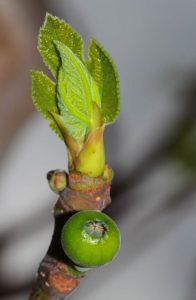Pentecost Sunday
[cvm_video id=”5497″]
Fruits of Spiritual Harvest: Figs
Fig trees are legendary for their abundant fruit harvests and were an idealized symbol of a land overflowing with prosperity and blessings. Their unique timeline of producing fruits before leaves, reminds us that the development of spiritual fruits should come first in our lives, before anything else.
Because fig trees were so common in the region, they were often closely associated with Israel, whose patriarchs and ancestors God lovingly refers to as “early fruit on the fig tree” (Hosea 9:10). Figs were also symbols of wealth, fortune, and stability as it was poetically painted that “During Solomon’s lifetime, Judah and Israel lived in safety, from Dan, even to Beer-Sheba, all [God’s People] under their vines and fig trees” (1 Kings 4:25).
Fig fruit, sap, and leaves have many important medical properties which include their high levels of flavonoids called luteolin which are strong antioxidants helping neutralize free radicals, making them highly effective in blocking the growth of tumors, aiding in the prevention and treatment of skin cancer. Prophet Isaiah received revelation from God and famously recommended applying a fig cake/poultice to King Hezekiah’s deadly “boil” (skin cancer) (ref. 2 Kings 20:1-7; Isaiah 38).
Fig trees often require extensive growing periods, often between three to seven years depending on the variety, to finally become established before a good crop can be expected. The vineyard owner of the Parable of the Barren Fig Tree (ref. Luke 13:6-8) would have understood this reality, so his complaint that the barren fig tree had not produced fruit for the past three years was not due to him being ignorant or impatient, since the plant was most likely fully matured already.
The vine-dresser who maintained the trees in the vineyard understood that the landowner had legitimate reasons to want to “cut [the barren fig tree] down”, because even though it had not be producing fruits, it would still be growing a huge amount of large green leaves and thus “using up the soil”. Suggesting that it should be aerated and fertilized to hopefully stimulate growth before the next year was a desperate effort by the vine-dresser to try to buy time to save it.
Nearly a year after the Parable of the Barren Fig Tree, when Jesus cursed the fig tree outside of Jerusalem (ref. Matthew 21:18-22; Mark 11:12-14, 20-25) the day before Passover, it was again for its lack of fruit. While Mark’s account specifies that it was not the time to expect ripened figs yet, many fig tree varieties produce an initial crop (breba or taqsh) in the early spring on the vegetative growth from the previous year, while the larger, more desired main crop develops in the summer on the current year’s growth. While the fig tree had leaves, which typically develop after the immature green fruits start to appear, since there is no early breba crop, it was a sign that the tree would most likely not be developing fruits that year at all.

The reason for the lack of fruit on the fig trees can possibly be attributed to a phenomenon called fruit drop, where a fig tree will unexpectedly lose all of its undeveloped green figs. While this can occur due to improper watering, soil nutrition, extreme and sudden weather shifts such as intense heat, cold, or strong wind (ref. Revelation 6:13), one of the most common reasons is a lack of fertilization.
Green figs are not actually immature fruits, but inverted (outside-in) flowers which are fertilized by a tiny fig wasp which enters through a minuscule hole called the ostiole. The characteristic crunch of figs are not wasps as some false rumors try to misinform, but seeds within the dozens of miniature fruits within the fig. If a fig “flower” is not fertilized it will not develop into the deliciously sweet fruit (ref. Judges 9:10-11) it is known for and will fall away. Likewise, one who is not filled with the Holy Spirit will not bear good fruits and will be cut down like the barren fig trees.
The first mention of figs is in the Garden of Eden, when, after eating of the Forbidden Fruit, Adam and Eve sewed aprons/tunics out of the fig tree’s characteristic large green leaves to cover their nakedness. This use of fig leaves as a covering may be a reference to a sense of external religiosity without the actual production of spiritual fruits as we saw with the previously mentioned barren fig trees symbolizing Israel.
When Disciple Philip found Disciple Nathanael to tell him about Jesus, Phillip references Christ as the “the one Moses wrote about in the Law and about [whom] the Prophets wrote about!” since Philip knew Nathanael’s focus was on deeply religious and dogmatic matters. Even Nathanael’s knee jerk reaction of “Nazareth! Can anything good come from there?” upon hearing of Christ’s hometown, was telling of his religious prejudice. Because Nazareth touched the borders of Gentile nations, it and all the people from there were therefore ritualistically unclean in Nathanael’s mind.
When Jesus first meets Nathanael, Christ makes a point of letting him know that He saw Nathanael under the fig tree. Nathanael, upon hearing this, overcomes his previous doubts and recognizes Jesus not just as “the son of Joseph” as Philip called Him, but declares Christ “the Son of God; the King of Israel” (ref. John 1:43-49). Nathanael’s response implies that “under the fig tree”, was not where Phillip found him and may have been a secret place Phillip did not know about and could not have mentioned to Jesus. It’s been suggested that “under the fig tree” may have been a place where Nathanael prayed and studied privately in peace, eagerly awaiting the Messiah.
Christ refers to Nathanael as “a true Israelite, in whom there is no deceit” because Nathanael was not just hypocritically and falsely clothed in religious dressings, like a fig tree producing only leaves. Though stumbling, Nathanael was already beginning to show signs of early fruits.
Fig trees are an impeccable representation of the loving patience God has for His People. He recognizes that the development of spiritual fruits takes time, often years, but that period must be spent building deep root systems, connecting intensely with God, and only after being filled with the Holy Spirit can many spiritual fruits begin to develop and ripen. In this way, we can begin to bring glory to our Creator by introducing sweetness into the lives of those around us and bringing healing to our diseased world.
Prepared by, Kent Simpson, Apostolic Prophet & Eric Sepulveda, PMT Administrator
For more prophetic media groups click here



